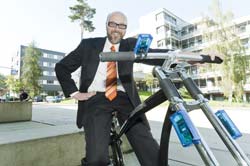Cebit 2012: The wireless bicycle brake, a prototype on an exciting mission

Holger Hermanns, computer science professor at Saarland University, confirmed the reliability of his wireless bicycle brake through mathematical calculations. Foto: Angelika Klein<br>
In view of that fact, computer scientists at Saarland University are designing mathematical calculations to check such systems automatically. The scientists will present their results at stand F34 in hall 26 at the computer fair Cebit. The trade show takes place in Hanover, Germany from March 6 to 10.
Professor Holger Hermanns, who holds the chair of Dependable Systems and Software, and who developed the wireless bicycle brake together with his group, explains: “Wireless networks are never a fail-safe method. That’s a fact that’s based on a technological background.” Nonetheless, the trend is to set up wireless systems that, like a simple bicycle brake, have to function all the time. “In the field of the future European Train Service, for example, concrete plans already exist,” Hermanns reports. Furthermore, he says that train and airplane experiments are far too sophisticated, and could even endanger the life of human beings in case of malfunction.
Therefore, the Saarland computer scientist’s mathematical methods should now verify the correct function and interaction of the components automatically. “The wireless bicycle brake gives us the necessary playground to optimize these methods for operation in much more complex systems,” Hermanns adds.
Therefore, his research group examines the brake prototype with algorithms that normally are used in control systems for aircraft or chemical factories. As a result, they found out that the brake works with 99.9999999999997 percent reliability. “This implies that out of a trillion braking attempts, we have three failures,” Hermanns explains and concludes: “That is not perfect, but acceptable.”
To brake with the wireless brake, a cyclist needs only clench the rubber grip on the right handle. The more tightly the grip is clenched, the harder the disk brake on the front wheel works. It seems as if a ghost hand is in play, but a combination of several electronic components enables the braking. Integrated in the rubber grip is a pressure sensor, which activates a sender if a specified pressure threshold is crossed. The sender is integrated in a blue plastic box which is the size of a cigarette packet and is attached to the handlebar.
Its radio signals are sent to a receiver attached at the end of the bicycle’s fork. The receiver forwards the signal to an actuator, transforming the radio signal into the mechanical power by which the disk brake is activated. The electrical energy is supplied by a battery, which is also attached to the bicycle’s fork.
To enhance reliability, there are additional senders attached to the bicycle. These repeatedly send the same signal.
Its current configuration enables the cruiser bike to brake within 250 milliseconds. This means that at a speed of 30 kilometers per hour, the cyclist has to react two meters before reaching the dangerous situation. But the Saarland University computer scientists are not satisfied with just this functionality. “It is not difficult to integrate an anti-lock braking system and traction control. That takes only a few adjustments,” Hermanns explains.
Researching the wireless bicycle brake was funded within the special research field “Automatic Verification and Analysis of Complex Systems (AVACS)” by the German Research Foundation. Besides Holger Hermanns, several researchers from Saarland University are involved. These are Professors Sebastian Hack, Markus Bläser, Reinhard Wilhelm, Jan Reineke, Bernd Finkbeiner and Verena Wolf.
Professor Kurt Mehlhorn and Christoph Weidenbach of the Max-Planck-Institute for Informatics in Saarbrücken are involved in the project, too. In 2011, the Research Foundation Group approved about 8.7 million euro, and about 3.5 million inure to the benefit of the Saarland research work. Since 2004, the special research group has been sponsored with approximately 26 million euros, and 9.5 million went to the computer scientists at Saarland University.
Media Contact
All latest news from the category: CeBIT 2012
Newest articles

An Endless Loop: How Some Bacteria Evolve Along With the Seasons
The longest natural metagenome time series ever collected, with microbes, reveals a startling evolutionary pattern on repeat. A Microbial “Groundhog Year” in Lake Mendota Like Bill Murray in the movie…

Witness Groundbreaking Research on Achilles Tendon Recovery
Achilles tendon injuries are common but challenging to monitor during recovery due to the limitations of current imaging techniques. Researchers, led by Associate Professor Zeng Nan from the International Graduate…

Why Prevention Is Better Than Cure—A Novel Approach to Infectious Disease Outbreaks
Researchers have come up with a new way to identify more infectious variants of viruses or bacteria that start spreading in humans – including those causing flu, COVID, whooping cough…